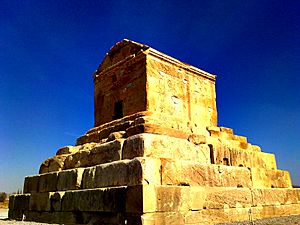Pasargadae facts for kids
|
پاسارگاد
|
|

Tomb of Cyrus the Great in Pasargadae
|
|
| Location | Fars Province, Iran |
|---|---|
| Region | Iran |
| Coordinates | 30°12′00″N 53°10′46″E / 30.20000°N 53.17944°E |
| Type | Settlement |
| History | |
| Builder | Cyrus the Great |
| Material | Stone, clay |
| Founded | 6th century BCE |
| Periods | Achaemenid Empire |
| Cultures | Persian |
| Site notes | |
| Archaeologists | Ali Sami, David Stronach, Ernst Herzfeld |
| Condition | In ruins |
| UNESCO World Heritage Site | |
| Criteria | Cultural: (i), (ii), (iii), (iv) |
| Inscription | 2004 (28th Session) |
| Area | 160 ha (0.62 sq mi) |
| Buffer zone | 7,127 ha (27.52 sq mi) |
Pasargadae was an important city in ancient Persia. Today, it is a famous historical site located in Fars Province, Iran. This city was the very first capital of the mighty Persian Empire.
The great Cyrus the Great started building Pasargadae around 546 BCE. However, he passed away in 530 BCE, so the city was never fully finished. Pasargadae remained the capital until Darius I built a new capital city called Persepolis. One of the most important structures in Pasargadae is the tomb of Cyrus the Great.
Pasargadae is recognized globally as a UNESCO World Heritage Site. This means it is a place of special cultural or physical importance.
Contents
History of Pasargadae
Building the First Capital
Pasargadae was chosen by Cyrus the Great to be the capital of his new empire. He began construction around 546 BCE. Cyrus built this city after his victory over the Median Empire. It was meant to be a symbol of his power and the beginning of the Achaemenid Empire.
The city was designed with large palaces and beautiful gardens. These gardens are thought to be some of the earliest examples of the famous Persian garden style. The design of Pasargadae showed off the new empire's strength and unique culture.
Life in the Ancient City
Even though Pasargadae was the first capital, it was not the main political center for very long. After Cyrus the Great died, Darius I moved the capital to Persepolis. This new city was built to be even grander.
However, Pasargadae remained a very important place. It was seen as the spiritual heart of the empire. The tomb of Cyrus the Great was here, making it a sacred site. Kings would often visit Pasargadae for important ceremonies.
What to See at Pasargadae
Pasargadae is now mostly in ruins, but you can still see many impressive structures. These ruins tell us a lot about the ancient Persian Empire.
Tomb of Cyrus the Great
The most famous building at Pasargadae is the Tomb of Cyrus the Great. It is a simple but grand stone structure. The tomb stands on a raised platform with six steps. It looks like a small house with a pointed roof.
This tomb has survived for over 2,500 years. It is a powerful reminder of one of history's most important leaders. Many people visit it to honor Cyrus the Great.
Palaces and Structures
Pasargadae was home to several royal buildings. These included the Audience Palace, the Private Palace, and the Gateway Palace. These palaces were built with large halls and columns. They showed off the wealth and power of the Persian kings.
- The Audience Palace: This was likely where the king met with important visitors.
- The Private Palace: This was probably where the king lived.
- The Gateway Palace: This was the main entrance to the royal area. It had a large hall and impressive carvings.
The Citadel
There is also a large fortified area known as the citadel. This was built on a hill and offered protection for the city. From the top, you can see the layout of the ancient city. It shows how well-planned Pasargadae was.
Pasargadae as a World Heritage Site
Pasargadae was made a UNESCO World Heritage Site in 2004. This recognition highlights its global importance. It is valued for its unique architecture and its connection to Cyrus the Great.
The site shows the earliest examples of Achaemenid architecture. It also represents the first great multicultural empire in history. Protecting Pasargadae helps us understand ancient civilizations. It also teaches us about the early history of Iran.
Images for kids
-
"I am Cyrus the king, an Achaemenid." in Old Persian, Elamite and Akkadian languages. It is carved in a column in Pasargadae
-
Dovetail Staples from Pasargadae
-
The tomb of Cyrus the Great in the Qajar period
-
Tomb of Cyrus the Great
-
Tomb of Cambyses I
-
The citadel of Pasargadae. At its top many column bases indicate the structure was not unlike the Athenian Acropolis in positioning and structure.
See also
 In Spanish: Pasargada para niños
In Spanish: Pasargada para niños













